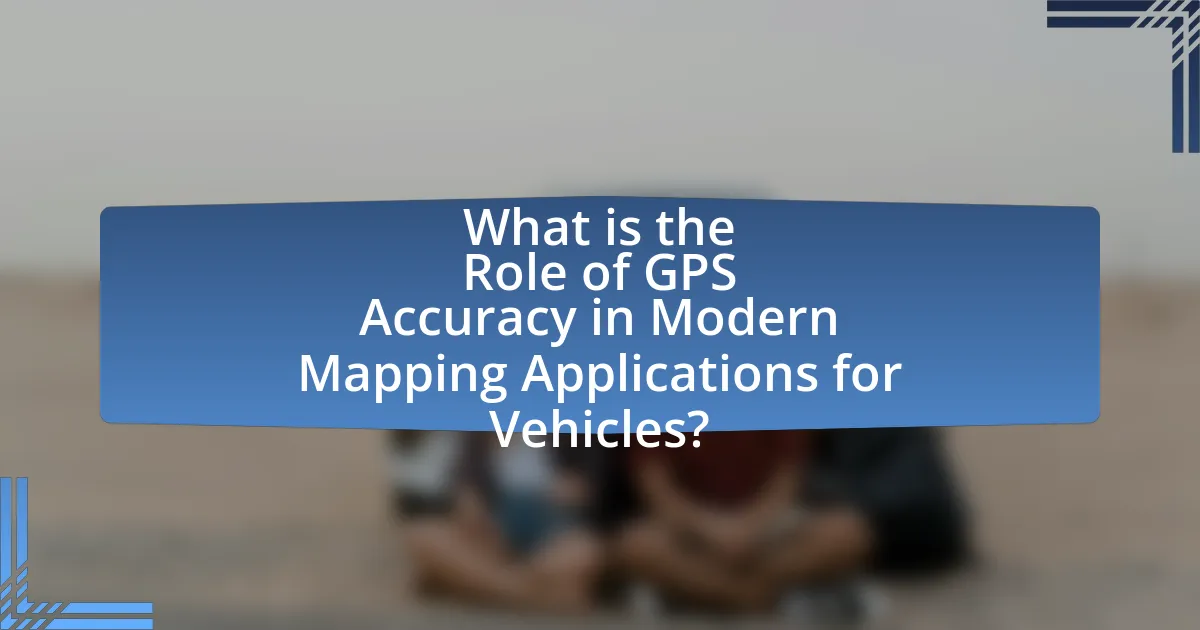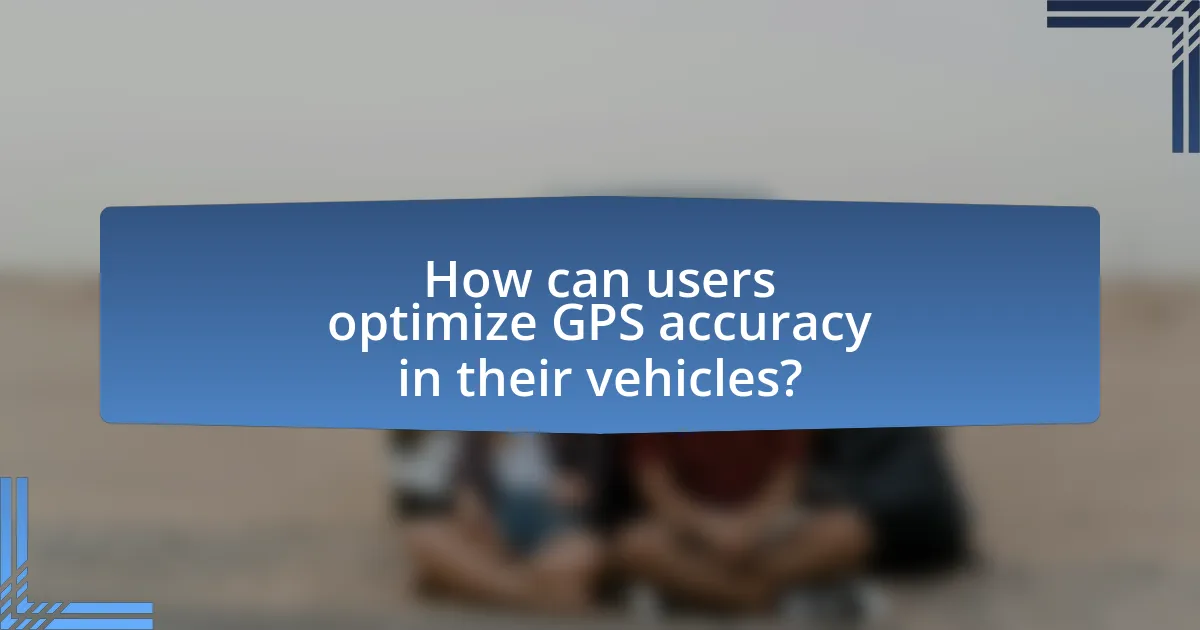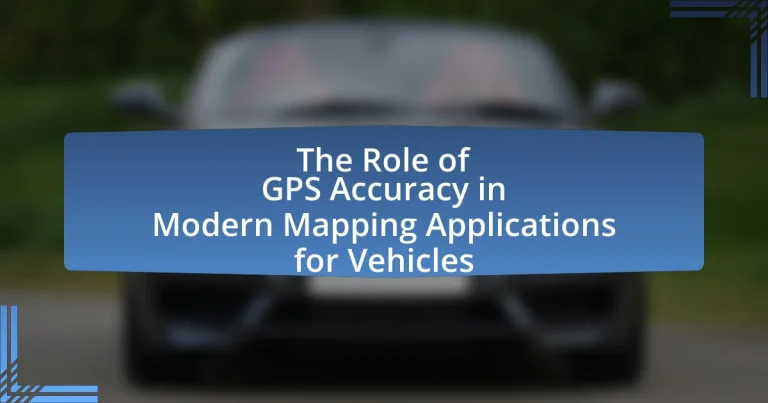GPS accuracy is a critical component in modern mapping applications for vehicles, significantly influencing navigation precision, safety, and traffic management. High accuracy levels enable vehicles to pinpoint their locations within centimeters, enhancing features such as real-time navigation, route optimization, and advanced driver-assistance systems (ADAS). Key factors affecting GPS accuracy include satellite geometry, atmospheric conditions, and signal quality, while advancements like multi-frequency GNSS and differential GPS are improving performance. The article explores the impact of GPS accuracy on vehicle navigation, real-time traffic updates, accident prevention, and the challenges posed by environmental factors, ultimately highlighting best practices for optimizing GPS functionality in vehicles.

What is the Role of GPS Accuracy in Modern Mapping Applications for Vehicles?
GPS accuracy is crucial in modern mapping applications for vehicles as it directly impacts navigation precision and safety. High GPS accuracy enables vehicles to determine their exact location within a few centimeters, which is essential for real-time navigation, route optimization, and collision avoidance systems. For instance, studies show that a GPS accuracy of less than 5 meters significantly enhances the effectiveness of advanced driver-assistance systems (ADAS), improving overall road safety and traffic management. Furthermore, accurate GPS data supports features like lane-level navigation and automated driving, which rely on precise location information to function effectively.
How does GPS accuracy impact vehicle navigation systems?
GPS accuracy directly impacts vehicle navigation systems by determining the precision of location data, which is crucial for route planning and real-time navigation. High GPS accuracy allows for precise positioning, enabling features such as turn-by-turn directions, traffic updates, and efficient route optimization. For instance, a study by the National Oceanic and Atmospheric Administration (NOAA) indicates that GPS systems can achieve accuracy within 1 to 3 meters under optimal conditions, significantly enhancing the reliability of navigation systems. Conversely, lower accuracy can lead to incorrect positioning, resulting in navigation errors, longer travel times, and increased fuel consumption. Thus, the effectiveness of vehicle navigation systems is heavily reliant on the accuracy of GPS signals.
What are the key factors that determine GPS accuracy?
The key factors that determine GPS accuracy include satellite geometry, atmospheric conditions, signal multipath, and receiver quality. Satellite geometry refers to the relative positions of satellites in the sky; optimal spacing improves accuracy. Atmospheric conditions, particularly ionospheric and tropospheric delays, can distort signals, affecting precision. Signal multipath occurs when GPS signals reflect off surfaces before reaching the receiver, leading to inaccuracies. Lastly, the quality of the GPS receiver itself, including its processing algorithms and hardware, significantly influences the accuracy of the location data obtained.
How does satellite positioning affect GPS accuracy?
Satellite positioning directly impacts GPS accuracy by determining the geometric arrangement of satellites relative to the receiver. When satellites are well-distributed across the sky, the GPS receiver can triangulate its position more accurately, reducing errors. Conversely, if satellites are clustered together or obstructed by buildings or terrain, the accuracy diminishes due to increased signal delay and multipath effects. Studies indicate that optimal satellite geometry can improve positional accuracy to within a few meters, while poor geometry can lead to errors exceeding 20 meters.
Why is GPS accuracy crucial for real-time traffic updates?
GPS accuracy is crucial for real-time traffic updates because it ensures precise location tracking of vehicles, which is essential for providing timely and relevant traffic information. Accurate GPS data allows navigation systems to calculate optimal routes, identify traffic congestion, and predict travel times effectively. For instance, studies show that a GPS accuracy of within 5 meters significantly enhances the reliability of traffic data, enabling systems to respond to real-time changes in traffic conditions. This precision is vital for applications like Google Maps and Waze, which rely on accurate positioning to deliver updates that can alter drivers’ routes based on current traffic situations.
How does accurate GPS data improve traffic management?
Accurate GPS data significantly enhances traffic management by providing real-time location information that enables efficient routing and congestion monitoring. This precision allows traffic management systems to analyze vehicle movements, predict traffic patterns, and optimize signal timings, thereby reducing delays. For instance, studies have shown that cities utilizing accurate GPS data can decrease travel times by up to 20% during peak hours, as it facilitates dynamic rerouting based on current traffic conditions. Additionally, accurate GPS data supports the implementation of intelligent transportation systems, which can adjust traffic signals in real-time to improve flow and minimize bottlenecks.
What role does GPS accuracy play in accident prevention?
GPS accuracy plays a critical role in accident prevention by providing precise location data that enhances navigation and situational awareness for drivers. Accurate GPS systems enable real-time tracking of vehicle positions, which helps in avoiding collisions by alerting drivers to potential hazards, such as obstacles or sudden changes in traffic conditions. Studies indicate that vehicles equipped with high-accuracy GPS can reduce accident rates by up to 30% by facilitating timely decision-making and improving route optimization. This data-driven approach not only aids in navigation but also supports advanced driver-assistance systems (ADAS) that rely on accurate positioning to function effectively, further contributing to overall road safety.

What are the challenges affecting GPS accuracy in vehicles?
GPS accuracy in vehicles is primarily challenged by factors such as signal obstruction, multipath effects, atmospheric conditions, and satellite geometry. Signal obstruction occurs when buildings, trees, or other structures block the direct line of sight to satellites, leading to inaccurate positioning. Multipath effects arise when GPS signals bounce off surfaces before reaching the receiver, causing delays and errors in location data. Atmospheric conditions, particularly ionospheric and tropospheric delays, can distort signals as they travel through the atmosphere. Lastly, poor satellite geometry, which refers to the relative positions of satellites in the sky, can result in less accurate triangulation of a vehicle’s position. These challenges collectively hinder the reliability of GPS systems in providing precise navigation and mapping for vehicles.
How do environmental factors influence GPS accuracy?
Environmental factors significantly influence GPS accuracy by affecting signal quality and reception. For instance, obstacles such as buildings, trees, and mountains can obstruct satellite signals, leading to multipath errors where signals bounce off surfaces before reaching the receiver. Atmospheric conditions, particularly ionospheric and tropospheric delays, can also distort signals, causing inaccuracies in positioning. Research indicates that urban environments can reduce GPS accuracy by up to 50% due to signal blockage and reflection, while adverse weather conditions like heavy rain or snow can further degrade performance.
What impact do urban canyons have on GPS signals?
Urban canyons significantly degrade GPS signals due to multipath effects and signal blockage. The tall buildings in urban environments reflect and scatter GPS signals, causing inaccuracies in positioning. Research indicates that GPS accuracy can be reduced by up to 50% in dense urban areas compared to open environments, as noted in studies conducted by the National Oceanic and Atmospheric Administration (NOAA). This degradation impacts navigation systems in vehicles, leading to errors in location tracking and route guidance.
How does weather affect GPS performance?
Weather significantly affects GPS performance by impacting signal quality and accuracy. Atmospheric conditions such as heavy rain, snow, and fog can cause signal attenuation, leading to reduced accuracy in positioning. For instance, rain can absorb and scatter GPS signals, while snow can create additional obstacles that interfere with signal reception. Studies have shown that severe weather can degrade GPS accuracy by as much as 50%, particularly in urban environments where multipath effects are prevalent. This degradation can result in positioning errors that hinder the effectiveness of GPS in modern mapping applications for vehicles.
What technological advancements are improving GPS accuracy?
Technological advancements improving GPS accuracy include the implementation of multi-frequency GNSS (Global Navigation Satellite System) signals, which enhance precision by reducing atmospheric interference. Additionally, advancements in satellite technology, such as the deployment of new satellites with improved signal strength and accuracy, contribute significantly to enhanced GPS performance. For instance, the European Union’s Galileo system provides higher accuracy levels than traditional GPS by utilizing additional satellites and advanced signal processing techniques. Furthermore, the integration of ground-based augmentation systems (GBAS) and real-time kinematic (RTK) positioning techniques allows for centimeter-level accuracy, which is crucial for applications in autonomous vehicles and precision mapping. These advancements collectively ensure that GPS technology meets the increasing demands for accuracy in modern mapping applications for vehicles.
How do multi-constellation systems enhance GPS reliability?
Multi-constellation systems enhance GPS reliability by providing access to signals from multiple satellite networks, such as GPS, GLONASS, Galileo, and BeiDou. This increased availability of satellites improves positioning accuracy and reduces the likelihood of signal loss due to obstructions or interference. For instance, having more satellites in view allows for better triangulation of a user’s position, which can lead to a reduction in positioning errors by up to 50% in challenging environments, such as urban canyons or dense forests. Additionally, multi-constellation systems can offer improved redundancy; if one satellite fails or is obstructed, others can maintain the integrity of the positioning solution, thereby ensuring continuous and reliable navigation for vehicles.
What role does differential GPS play in enhancing accuracy?
Differential GPS (DGPS) significantly enhances accuracy by correcting the standard GPS signals using a network of fixed ground-based reference stations. These reference stations calculate the difference between their known positions and the positions reported by GPS satellites, allowing them to transmit correction signals to nearby GPS receivers. This process reduces positioning errors from about 10-20 meters to within 1-3 meters, making DGPS crucial for applications requiring high precision, such as vehicle navigation and mapping. Studies have shown that DGPS can improve accuracy by up to 95%, demonstrating its effectiveness in modern mapping applications for vehicles.

How can users optimize GPS accuracy in their vehicles?
Users can optimize GPS accuracy in their vehicles by ensuring a clear line of sight to the sky, minimizing obstructions such as tall buildings and trees. This is crucial because GPS signals can be weakened or blocked by physical barriers, leading to inaccuracies. Additionally, keeping the GPS device updated with the latest software and maps enhances performance, as manufacturers often release updates that improve accuracy and fix bugs. Regularly calibrating the GPS system can also help maintain precision, as it ensures that the device is functioning correctly. According to a study by the National Oceanic and Atmospheric Administration, maintaining a clear view of the sky can improve GPS accuracy by up to 95% in urban environments.
What best practices should drivers follow for better GPS performance?
Drivers should ensure a clear line of sight to the sky for optimal GPS performance. This practice is crucial because GPS signals can be obstructed by buildings, trees, and other structures, leading to inaccuracies. Additionally, drivers should keep their GPS devices updated with the latest software and maps, as outdated information can hinder performance. Regularly checking for updates ensures that the device has the most accurate data available. Furthermore, drivers should avoid using GPS in areas known for poor signal reception, such as tunnels or densely built urban environments, where signal loss is common. These best practices collectively enhance GPS accuracy and reliability, ensuring better navigation experiences.
How can regular updates improve GPS accuracy?
Regular updates can significantly improve GPS accuracy by ensuring that the system utilizes the latest satellite data and correction algorithms. These updates help to refine position calculations by incorporating real-time information about satellite positions, atmospheric conditions, and potential signal obstructions. For instance, the Global Positioning System (GPS) relies on a network of satellites that transmit signals to receivers; if these satellites are updated with new orbital data and corrections, the accuracy of the location determined by the GPS receiver improves. Studies have shown that regular updates can reduce positional errors from several meters to within centimeters, enhancing navigation precision for vehicles in modern mapping applications.
What settings should be adjusted for optimal GPS functionality?
To achieve optimal GPS functionality, users should adjust the following settings: enable high accuracy mode, ensure location services are turned on, and allow background app refresh for GPS-dependent applications. High accuracy mode utilizes GPS, Wi-Fi, Bluetooth, and mobile networks to provide the most precise location data, which is crucial for modern mapping applications in vehicles. Location services must be activated to allow the device to access GPS signals, while background app refresh ensures that mapping applications can continuously update location information, enhancing navigation accuracy. These adjustments are supported by studies indicating that devices configured for high accuracy can improve location precision by up to 50% compared to standard settings.
What common troubleshooting steps can enhance GPS accuracy?
To enhance GPS accuracy, users should ensure a clear line of sight to the sky, as obstructions like buildings and trees can interfere with satellite signals. Additionally, regularly updating GPS software and maps can improve performance, as manufacturers often release updates that fix bugs and enhance functionality. Checking for interference from electronic devices, such as mobile phones or radios, is also crucial, as these can disrupt GPS signals. Furthermore, using a GPS device with a high-quality antenna can significantly improve signal reception and accuracy. These steps are supported by studies indicating that environmental factors and device quality directly impact GPS performance.


